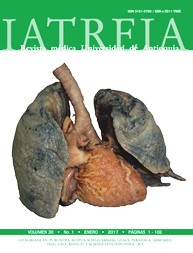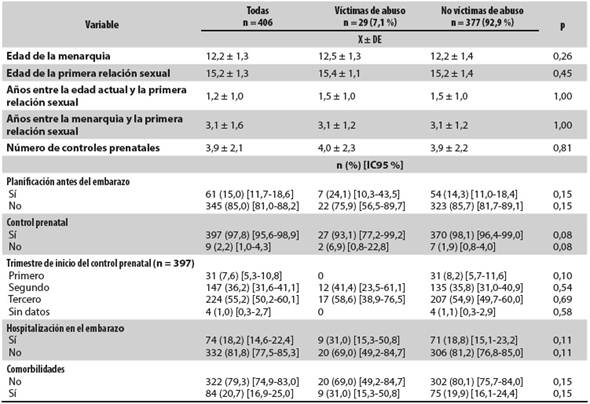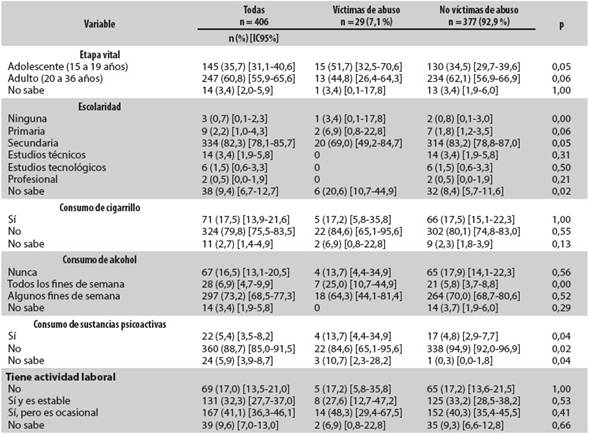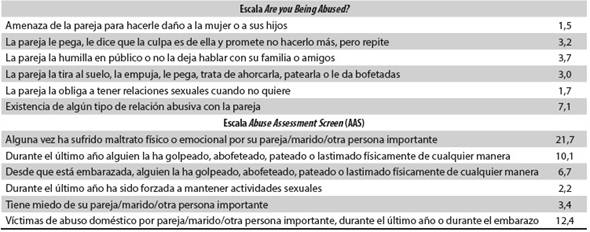Domestic violence in pregnant adolescents: Characterization of the partners and prevalence of the different forms of expression
DOI:
https://doi.org/10.17533/udea.iatreia.v30n1a03Keywords:
adolescent health services, adolescent pregnancy, domestic violence, spouse abuseAbstract
Introduction: Pregnancy in adolescents and domestic violence (DV) are worldwide problems. Their prevalence is influenced by cultural factors. Objectives: To characterize pregnant adolescents and their sexual partners, and to determine the prevalence of psychological, physical and sexual DV.
Methodology: Cross-sectional study of 406 Colombian pregnant teenagers. Socio-demographic data were collected, and the scales “Are you being abused?” and “Abuse Assessment Screen” were applied. The former identifies domestic violence by the partner, and the latter, DV at any moment, the last year or during pregnancy.
Results: Age: 16.5 ± 1.5 years, 92.9 % were in late adolescence, average years of schooling: nine; 50 % dropped out from school when they became pregnant; 70 % depended on their parents, both before and after pregnancy. DV by the partner: 7.1 %; physical DV: 6.7 %; psychological DV: 3.7 %; sexual DV: 2.2 %. DV by partner/husband/other person: 12.4 %; physical or emotional abuse by partner/another person: 21.7 %; fear from the partner: 3.4 %. There was significant association between alcohol consumption by the partner every weekend and DV.
Conclusion: Frequency of DV against pregnant adolescents is high and alcohol consumption by the partner is an important risk factor for it.
Downloads
References
(1.) Monterrosa-Castro A. Causas e implicaciones médico - sociales del embarazo en la adolescencia. Rev Colom Obstet Ginecol. 1998 Oct-Dic;49(4):225-30.
(2.) Profamilia. Encuesta Nacional de Demografía y Salud-2010 [Internet]. Bogotá: Profamilia; 2011 [Consultado 2015 Abr 12]. Disponible en: https://www.minsalud.gov.co/sites/rid/Lists/BibliotecaDigital/RIDE/VS/ED/GCFI/Base%20de%20datos%20ENDS%20
%20informe.pdf
(3.) Mikton C. Preventing intimate partner and sexual violence against women: taking action and generating evidence. Inj Prev. 2010 Oct;16(5):359-60. DOI 10.1136/ip.2010.029629.
(4.) Organización Mundial de la Salud, Organización Panamericana de la Salud. Comprender y abordar la violencia contra las mujeres: Violencia infligida por la pareja [Internet]. Washington,DC : OPS; 2013. [Consultado 2015 Feb 23]. Disponible en: http://apps.who.int/iris/bitstream/10665/98816/1/WHO_RHR_12.36_spa.pdf?ua=1
(5.) Daoud N, Urquia ML, O’Campo P, Heaman M, Janssen PA, Smylie J, et al. Prevalence of abuse and violence before, during, and after pregnancy in a national sample of Canadian women. Am J Public Health. 2012 Oct;102(10):1893-901.
(6.) Stern C. Vulnerabilidad social y embarazo en adolescente en México. Papeles de población. 2004;39:129-58.
(7.) American Congress of Obstetricians and Gynecologists [Internet]. Washington, DC: 2010 [Cited 2013 Feb 12]. Are you being abused? Available from: http://www.acog.org/About_ACOG/ACOG_Departments/Violence_Against_Women/Are_you_Being_Abused
(8.) Rabin RF, Jennings JM, Campbell JC, Bair-Merritt MH. Intimate partner violence screening tools: a systematic review. Am J Prev Med. 2009 May;36(5):439-45.e4. DOI 10.1016/j.amepre.2009.01.024.
(9.) Díaz-Olavarrieta C, Paz F, Abuabara K, Martínez Ayala HB, Kolstad K, Palermo T. Abuse during pregnancy in Mexico City. Int J Gynaecol Obstet. 2007 Apr;97(1):57-64.
(10.) Arteta-Acosta C, Monterrosa-Castro Á, Ulloque-Caamaño L. Prevalencia de violencia doméstica gestacional según el ingreso económico de las naciones. En Prensa.
(11.) Moraes CL, Reichenheim ME. Domestic violence during pregnancy in Rio de Janeiro, Brazil. Int J Gynaecol Obstet. 2002 Dec;79(3):269-77.
(12.) Rodrigues DP, Gomes-Sponholz FA, Stefanelo J, Nakano AM, Monteiro JC. [Intimate partner violence against pregnant women: study about the repercussions on the obstetric and neonatal results]. Rev Esc Enferm USP. 2014 Apr;48(2):206-13. Portuguese.
(13.) Silva EP, Ludermir AB, Araújo TV, Valongueiro SA. Frequency and pattern of intimate partner violence before, during and after pregnancy. Rev Saude Publica. 2011 Dec;45(6):1044-53.
(14.) Costa Ribeiro MR, Moura da Silva AA, Seabra de Britto e Alves MT, Lucena Batista RF, Leitão Nunes de Rocha LM, Schraiber LB, et al. Psychological violence against pregnant women in a prenatal care cohort: rates and associated factors in Sao Luís, Brazil. BMC Pregnancy Childbirth. 2014 Feb;14:66. DOI 10.1186/1471-2393-14-66.
(15.) Onoh R, Umeora O, Ezeonu P, Onyebuchi A, Lawani O, Agwu U. Prevalence, pattern and consequences of intimate partner violence during pregnancy at abakaliki southeast Nigeria. Ann Med Health Sci Res. 2013 Oct;3(4):484-91. DOI 10.4103/2141-9248.122048.
(16.) Makayoto LA, Omolo J, Kamweya AM, Harder VS, Mutai J. Prevalence and associated factors of intimate partner violence among pregnant women attending Kisumu District Hospital, Kenya. Matern Child Health J. 2013 Apr;17(3):441-7. DOI 10.1007/s10995-012-1015-x.
(17.) Reichenheim ME, Moraes CL. Comparison between the abuse assessment screen and the revised conflict tactics scales for measuring physical violence during pregnancy. J Epidemiol Community Health. 2004 Jun;58(6):523-7.
(18.) Johri M, Morales RE, Boivin JF, Samayoa BE, Hoch JS, Grazioso CF, et al. Increased risk of miscarriage among women experiencing physical or sexual intimate partner violence during pregnancy in Guatemala City, Guatemala: cross-sectional study. BMC Pregnancy Childbirth. 2011 Jul;11:49. DOI 10.1186/1471-2393-11-49.
(19.) Salazar M, San Sebastian M. Violence against women and unintended pregnancies in Nicaragua: a population-based multilevel study. BMC Womens Health. 2014 Feb;14:26. DOI 10.1186/1472-6874-14-26.
(20.) Han A, Stewart DE. Maternal and fetal outcomes of intimate partner violence associated with pregnancy in the Latin American and Caribbean region. Int J Gynaecol Obstet. 2014 Jan;124(1):6-11. DOI 10.1016/j.ijgo.2013.06.037.
(21.) Das S, Bapat U, Shah More N, Alcock G, Joshi W, Pantvaidya S, et al. Intimate partner violence against women during and after pregnancy: a cross-sectional study in Mumbai slums. BMC Public Health. 2013 Sep;13:817. DOI 10.1186/1471-2458-13-817.
(22.) Curry MA, Doyle BA, Gilhooley J. Abuse among pregnant adolescents: differences by developmental age. MCN Am J Matern Child Nurs. 1998 May-Jun;23(3):144-50.
(23.) Stöckl H, Filippi V, Watts C, Mbwambo JK. Induced abortion, pregnancy loss and intimate partner violence in Tanzania: a population based study. BMC Pregnancy Childbirth. 2012 Mar;12:12. DOI 10.1186/1471-2393-12-12.
(24.) Shamu S, Abrahams N, Temmerman M, Musekiwa A, Zarowsky C. A systematic review of African studies on intimate partner violence against pregnant women: prevalence and risk factors. PLoS One. 2011 Mar;6(3):e17591. DOI 10.1371/journal.pone.0017591.
(25.) Shamu S, Abrahams N, Zarowsky C, Shefer T, Temmerman M. Intimate partner violence during pregnancy in Zimbabwe: a cross-sectional study of prevalence, predictors and associations with HIV. Trop Med Int Health. 2013 Jun;18(6):696-711. DOI 10.1111/tmi.12078.
(26.) Hajikhani Golchin NA, Hamzehgardeshi Z, Hamzehgardeshi L, Shirzad Ahoodashti M. Sociodemographic characteristics of pregnant women exposed to domestic violence during pregnancy in an Iranian setting. Iran Red Crescent Med J. 2014 Apr;16(4):e11989. DOI 10.5812/ircmj.11989.
(27.) Kamal SM. Domestic Violence, Unwanted Pregnancy and Pregnancy Termination among Urban Women of Bangladesh. J Family Reprod Health. 2013 Mar;7(1):11-22.
(28.) Alhusen JL, Frohman N, Purcell G. Intimate partner violence and suicidal ideation in pregnant women. Arch Womens Ment Health. 2015 Aug;18(4):573-8. DOI 10.1007/s00737-015-0515-2.
(29.) Jamshidimanesh M, Soleymani M, Ebrahimi E, Hosseini F. Domestic violence against pregnant women in iran. J Family Reprod Health. 2013 Mar;7(1):7-10.
(30.) Finnbogadóttir H, Dykes AK, Wann-Hansson C. Prevalence of domestic violence during pregnancy and related risk factors: a cross-sectional study in southern Sweden. BMC Womens Health. 2014 May;14:63. DOI 10.1186/1472-6874-14-63.
Published
How to Cite
Issue
Section
License
Copyright (c) 2016 Iatreia

This work is licensed under a Creative Commons Attribution-ShareAlike 4.0 International License.
Papers published in the journal are available for use under the Creative Commons license, specifically Attribution-NonCommercial-ShareAlike 4.0 International.
The papers must be unpublished and sent exclusively to the Journal Iatreia; the author uploading the contribution is required to submit two fully completed formats: article submission and authorship responsibility.


















